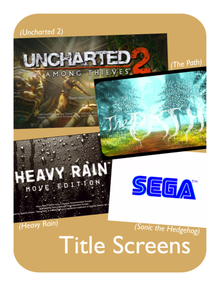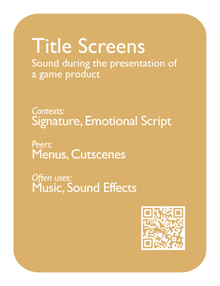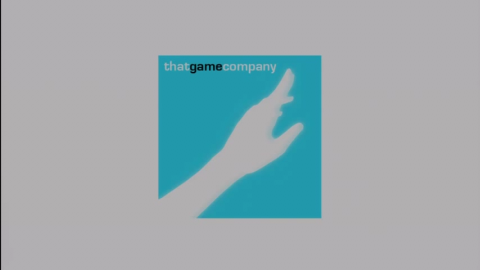Difference between revisions of "Title Screens"
ValterAlves (Talk | contribs) m |
ValterAlves (Talk | contribs) m |
||
| Line 25: | Line 25: | ||
| revisions =Introduced in version 1.0 | | revisions =Introduced in version 1.0 | ||
| description= | | description= | ||
| − | [[Title Screens]] constitute one of the distinct components of sound design in games, along with the introductory [[Menus]], [[Cutscenes]], and – the more | + | [[Title Screens]] constitute one of the distinct components of sound design in games, along with the introductory [[Menus]], [[Cutscenes]], and – the more "extensive" component – the sound occurring during gameplay. |
It is noticeable that some games extend their [[Title Screens]] back to the presentation of distributor and development teams, mostly by customizing the respective logos with motifs from the game, sometimes resorting solely to sound (typically astonishing [[Sound Effects]]). | It is noticeable that some games extend their [[Title Screens]] back to the presentation of distributor and development teams, mostly by customizing the respective logos with motifs from the game, sometimes resorting solely to sound (typically astonishing [[Sound Effects]]). | ||
Latest revision as of 16:08, 26 August 2012

|

| |
| The card's front face | The card's back face |
Contents
Synopsis
| Sound during the presentation of a game product. |
Relationships
Contexts:
Signature ![]() , Emotional Script
, Emotional Script ![]() .
.
Peers:
Menus ![]() , Cutscenes
, Cutscenes ![]() .
.
Often uses:
Music ![]() , Sound Effects
, Sound Effects ![]() .
.
Description
Title Screens constitute one of the distinct components of sound design in games, along with the introductory Menus, Cutscenes, and – the more "extensive" component – the sound occurring during gameplay.
It is noticeable that some games extend their Title Screens back to the presentation of distributor and development teams, mostly by customizing the respective logos with motifs from the game, sometimes resorting solely to sound (typically astonishing Sound Effects).
Although the exposition of the player to the Title Screens is very short when compared with the other sound design components, it constitutes the first contact of the player with the game, both when first running and in each new session. Being so, it plays an emotional role that sound can help to explore. Actually, the use of sound during Title Screens, including in those cases when is it starts early during the teams' presentations, has a role almost strictly emotional (so it may work as a first contribution to the Emotional Script).
Music is a prevalent solution for Title Screens, sometimes becoming part of the Signature of the game.
Examples
  Sonic the Hedgehog: Same games from Sega, including Sonic the Hedgehog, share a short Signature that is used in Title Screens but which is repeated along the gaming session, between levels.
|










